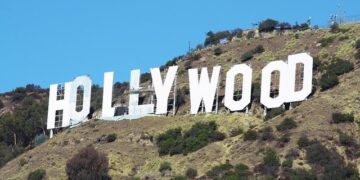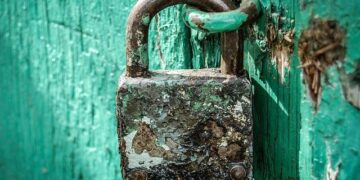By his own admission, Richard Fortus is there to support his co-guitarist as best he can and ultimately serve the song. Not that he knows which song will be coming next on any given night, mind, due to the way that singer Axl Rose runs the show…
“Set list, you say!” he laughs, talking to TG from Saratoga Springs, New York, during the band’s ongoing We’re F’N’ Back! Tour. “It varies night to night and there’s no list. Basically, Axl will just call out the songs. Quite often there are groups of songs that we all know go together, but it’s all up in the air. Axl will call it as he feels it!”
Today, Richard talks about his journey in Guns N’ Roses, from his involvement on 2008’s criminally underrated Chinese Democracy to those recent tracks on which he features alongside Slash – Hard Skool, Absurd, and the recent release, Perhaps.
As an avid collector of gear, he reveals his favorite tools of the trade, and he explains the key to his working relationship with Slash – understanding the different roles required both musically and tonally in order to create a wider sonic picture…
It’s interesting how you and Slash vary from playing the same exact riff in the same positions to other chordal ideas on different areas of the neck…
“I try to look at my job in Guns N’ Roses as supporting what Slash does. I’ll listen to what he’s doing and figure out the best way to fit into that. If that means playing a unison riff to push the idea further to the front, then I’ll do that. Or I might play around what he’s doing. It all comes down to listening and doing my very best to support the song. That always comes first!”
It’s a very similar dynamic to the Izzy Stradlin and Slash years, in that regard. You and Izzy ended up becoming friends when he was occasionally guesting before the reunion tour.
“Yeah! At various points, Izzy would come out and do shows with us. Me and him would end up hanging out and going to museums or jamming backstage. We have a very similar musical background, like, we came from the same school of playing.
“But I guess that also goes for Slash and Duff [McKagan] – we all come from listening to the same kind of bands. There are a lot of shared influences and The Rolling Stones are definitely one of the big ones.”
Izzy would do very simple, single-note lines to outline a chord or progression – very much in a Chuck Berry or Bo Diddley kind of way, and that worked beautifully with Slash’s heavier and thicker sound
What exactly did you like about Izzy’s playing on those classic Guns records?
“It’s that fundamental, arguably more simplistic approach. Juxtaposed against Slash’s musical voice, it really created something really special. Even more so with the writing, because Izzy’s ideas came from a very basic and rootsy place, while Slash has always been more of an evolved player.
“The combination of the two fit really well. Izzy comes from the Keith Richards approach to guitar – as opposed to the Jimmy Page one, which is closer to Slash. Izzy would do very simple, single-note lines to outline a chord or progression – very much in a Chuck Berry or Bo Diddley kind of way, and that worked beautifully with Slash’s heavier and thicker sound.”
Another big difference between stage left and stage right is how much gain is being used. Slash tends to have more firepower while you tend to live on an edge-of-breakup crunch.
“I tend to gravitate to that type of tone more. It’s also what helps in supporting Slash’s sound, because listeners can differentiate. When me and Slash first started working together, I really loved P-90 pickups and PAFs, but finding the right sound to fit around his tone was actually quite a challenge.
“I ended up going down the same route as Malcolm Young, using Gretsch Filter’Trons. That works so well in conjunction with another player using more gain and a PAF-style humbucker. Filter’Trons have more low-end and top-end, so if you’re not using much gain, because gain and output seem to bring out more mids, it helps bring out a player like Slash, who is more mid-focused.
“That’s why Gretsch guitars and less gain made sense for me in Guns N’ Roses. Using a P-90 didn’t really work, because that’s another mid-heavy pickup. I found it would just fight too much with Slash’s side of the stage. The Filter’Trons are the perfect way to sit around and stay out of his sonic space.”
You have an impressively diverse musical background – from your work with The Psychedelic Furs and Thin Lizzy to Rihanna, Enrique Iglesias, and NSYNC. What taught you most about the art of rhythm guitar?
“What did more for my rhythm chops than anything else was playing in a zydeco band! I was in one for a few years back when I was in New York doing sessions. I’d play with this group who were quite big locally and we’d play all over the city.
“Rhythmically, what that gig did for my guitar playing was huge. It’s a different pocket to sit in, rooted in early funk stuff like The Meters and The Neville Brothers. It made me focus on rhythm in a different way and really improved it.”
And, as many players find, learning more about other styles can do wonders for your rock playing…
“Listening to a lot of different styles of music is really helpful. Say with funk stuff, there is so much importance on finding the groove. That can do a lot for your rock playing, because you learn how to lock in with the drummer.
“Even if it’s a simple and repetitive pattern, you have to make it sit right. I used to sit and analyse what was going on with The Meters and why those interlocking parts sounded so magical.
“I found it fascinating, looking at what pushes and pulls and what makes it feel that way. There can be so many minute details in simple parts, like how the player pushes on the one or somewhere else.”
Unlike lead guitar, rhythm playing can often be quite deceiving in that it might sound easier than it actually is.
“It’s all about the little things. Nowadays with the internet, you can listen to isolated Malcolm Young tracks from the records and live performances. And it’s just impeccable. There was such an art to what he did because of all those little details.
“Okay, it was generally simple – we’re not talking 9th, 11th, or 13th chords – it was root and fifth for the most part. But it was all about where he placed those chords in the beat and how he accentuated them. It couldn’t be more simple and yet it couldn’t be more complex.
“Rhythm guitar is all about looking at those details because they are so often overlooked. Understanding what creates a groove is fundamental to rhythm playing. That’s why Hendrix was magical. What his right hand was doing on Killing Floor set up this groove that was so special.”
Similar things could be said of Stevie Ray Vaughan on songs like Pride And Joy, Love Struck Baby and Crossfire.
“What Stevie’s right hand was doing was just ridiculous. He’s a great example of someone who was so rhythmically advanced. That shuffle on Pride And Joy is something else. Things like that are overlooked by a lot of modern players. People tend to focus on the athletics of shred because it’s fun and gives you a sense of accomplishment.
“One of the best ways to get better at rhythm guitar is to record yourself and listen back to see if you are locking in, or able to manipulate feel by where you place your accents. Why does one bar feel so good and the other feel stiff? You have to ask yourself these questions. With modern technology you can actually look at the grid and see it with your own eyes.
It’s easy for guitarists to forget that – unless you’re Steve Vai or Yngwie Malmsteen – most musical situations will be predominantly rhythm-based…
“It’s much more rare to get called in to do lead parts when you’re doing TV commercials or playing on somebody else’s album. Usually you’re there to be focused on rhythm. Locking in is so important… that’s what gets you gigs! I would always focus on the two and four – those had to be right on with the drummer and if I did that right, everything else would fall into place.”
Another big difference between rhythm and lead players is in the economy of motion. Shredders are taught to minimize movement while open chord aficionados are encouraged to strike hard from afar, which is something we’ve seen you do a lot.
“For me, that comes from listening to Pete Townshend in The Who, or Dave Davies in The Kinks. Those guys attacked their strings. You can actually hear the notes going slightly sharp and then falling back in. That creates an excitement because you can tell they fuckin’ mean it. It was the same with Malcolm, that guy would shred picks. It’s like he would pick them up and they’d turn to dust!
“That was partly down to using thicker strings, too. Stevie Ray was similar in that sense. That’s how you get that fat tone. You can’t use too much gain when playing like that, it just doesn’t seem to work as well.
“That’s why I like to set my amps so they’re just on the edge of breakup. I use a single channel amp, so I play soft and use fingers for my clean tone. It all comes from my hands and how I attack the strings. It’s more about expression… that’s what turns me on about music.”
I use a single channel amp, so I play soft and use fingers for my clean tone. It all comes from my hands and how I attack the strings
Can you talk us through what you used on Chinese Democracy and which songs you’re most proud of?
“I really like what I did on Better. As far as what I used, there was a Tele and a ’59 tweed Twin on a lot of stuff. I also used my 1973 Marshall Super Lead [originally owned by Mötley Crüe’s Mick Mars and modded by José Arredondo]. There was a Firebird I used quite a bit. There was some Gretsch but not a whole lot. All of the players on that record sounded great.
“Robin [Finck] was just brilliant throughout, especially his solo on Better. He’s such a passionate player, I love what he does. Buckethead’s parts were absolutely breath-taking and mind-blowing. The precision of his right hand – oh my god, it’s crazy!”
So what exactly did you end up using on the new Guns N’ Roses tracks like Hard Skool, Absurd and Perhaps?
“Perhaps is a real mid-tempo song with that Elton John kind of groove. I like that one a lot. I mainly stuck with my signature Gretsch and an older 6120 from 1958. Those got plugged through a Park JTM45 from 1966 in conjunction with a 1959 Fender Bassman. That combination ended up being a favourite of mine.
“For the heavier stuff, I would use this old Orange that was modded by Obeid Khan, a good friend who does all my amp stuff. He’s also my neighbour! He designed all the amps that I’m using live, all the Magnatone stuff – and we also used some Magnatones on the new material.
“I also have a JTM45/100 that I would use in conjunction with the tweed Twin or a 3×10 Fender Bandmaster. Those seem to be the ones I liked most.”
And as for the pedalboard, have there been any recent changes, or is there anything new that’s currently blowing your mind?
“The main change recently is that I swapped out my Arion SCH-Z chorus for a Way Huge Blue Hippo. Jeorge Tripps made one for me and it does what the Arion did but slightly better and more three-dimensional. I set it with everything up for a Leslie kind of effect. That sound got used a lot on Chinese Democracy so I will use it on those songs, as well as the beginning of Live And Let Die. I’ve also been digging the Octonaut Hyperdrive by Interstellar Audio.
“As far as Klon-style pedals go, that’s one of the best, along with the Scream Honey Overdrive by CKK. I love my SoloDallas Schaffer Replica – that’s a huge part of the sound. And I’m still obsessed with my Lovepedal Eternity. I’ve been using that for almost 20 years.
“I keep trying to find something better but nothing knocks it off the ’board. I recently switched delays, I’m using the bigger Jam Delay Llama Xtreme which has the three presets plus modulation and does all my longer delays. I tend to paint from a broad palette. I like using lots of colours and have a lot to choose from… that’s probably why I love pedals so much!”
>>> Read full article>>>
Copyright for syndicated content belongs to the linked Source : GuitarWorld – https://www.guitarworld.com/features/richard-fortus-guns-n-roses-talks-rhythm-guitar


















![[News] Japan Develops 10nm Nanoimprint Technology, with Potential to Tackle EUV Bottleneck – TrendForce](https://earth-news.info/wp-content/uploads/2025/12/329851-news-japan-develops-10nm-nanoimprint-technology-with-potential-to-tackle-euv-bottleneck-trendforce-360x180.jpg)











